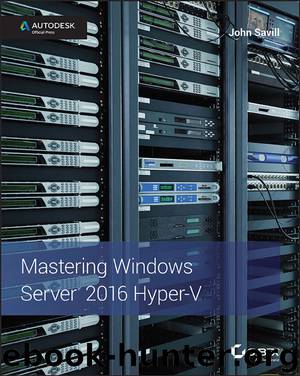Mastering Windows Server 2016 Hyper-V by John Savill

Author:John Savill [Savill, John]
Language: eng
Format: azw3
ISBN: 9781119286202
Publisher: Wiley
Published: 2016-11-29T05:00:00+00:00
When virtualization is used in an environment, there is often a decision to be made as to whether backups will be taken from the virtualization host of the virtual machines, or backup agents should still run within the virtual machines and backups will be taken from inside the virtual machines. There is no “right” answer to which is the best approach, but what is running inside the virtual machines and where you take the backup can have a big impact on the granularity of any restore operations that are performed.
Windows Server has long standardized on the Volume Shadow Copy Service (VSS), which provides facilities that allow application vendors to write special VSS writers. These application-specific modules, which are used to ensure that application data is ready for backup, are registered with the operating system on which the application is installed. All VSS writers registered on an operating system are called during a shadow copy backup initiated by a VSS-aware backup program. The VSS writers ensure that all data on disk for the application is in an application-consistent state and that other writers are quiesced (which means paused during the operation) while the backup is taken, maintaining the integrity of the on-disk data being backed up. An application-consistent backup means that the data is in a suitable state to be restored and used without corruption problems.
If a backup was taken at the Hyper-V host level of all virtual machine assets, primarily the VHD files, then ordinarily the virtual machine would know nothing of the backup being taken at the host level, so the data backed up would likely not be in an application-consistent state. Hyper-V Integration Services includes a Backup (volume snapshot) service, and this allows the Hyper-V host to notify each virtual machine when a VSS backup is taken. The process then looks like the following and ensures that backups of the virtual machines are in an application-consistent state:
The backup software (the VSS requestor) on the Hyper-V server makes a request for a VSS snapshot and enumerates the VSS writers (for example, the Hyper-V VSS writer) on the system to ascertain that the data that can be backed up with VSS.
The Hyper-V VSS writer (in conjunction with the VSS coordination service) forwards the VSS snapshot request to each guest operating system via the Backup integration service.
Each guest operating system thinks it is receiving a native VSS request and proceeds to notify all VSS writers on the guest to prepare for a snapshot.
Each VSS writer in the guest operating systems writes any information to disk that relates to its service (for example, Exchange and SQL) and notifies the VSS coordinator that it is ready for a snapshot and tells it which data to back up (although this part is ignored because we’ll be backing up the entire VHD from the Hyper-V host).
The Backup integration service for each VM tells the Hyper-V VSS writer that it is ready for a snapshot to be taken, and the Hyper-V VSS writer notifies the backup application via the VSS coordinator that it is ready for a snapshot.
Download
This site does not store any files on its server. We only index and link to content provided by other sites. Please contact the content providers to delete copyright contents if any and email us, we'll remove relevant links or contents immediately.
Kotlin in Action by Dmitry Jemerov(17250)
Grails in Action by Glen Smith Peter Ledbrook(15436)
Sass and Compass in Action by Wynn Netherland Nathan Weizenbaum Chris Eppstein Brandon Mathis(13293)
Azure Containers Explained by Wesley Haakman & Richard Hooper(7499)
Configuring Windows Server Hybrid Advanced Services Exam Ref AZ-801 by Chris Gill(7497)
Running Windows Containers on AWS by Marcio Morales(7054)
Microsoft 365 Identity and Services Exam Guide MS-100 by Aaron Guilmette(5436)
Microsoft Cybersecurity Architect Exam Ref SC-100 by Dwayne Natwick(5273)
Combating Crime on the Dark Web by Nearchos Nearchou(5018)
The Ruby Workshop by Akshat Paul Peter Philips Dániel Szabó and Cheyne Wallace(4701)
Management Strategies for the Cloud Revolution: How Cloud Computing Is Transforming Business and Why You Can't Afford to Be Left Behind by Charles Babcock(4550)
Python for Security and Networking - Third Edition by José Manuel Ortega(4274)
The Age of Surveillance Capitalism by Shoshana Zuboff(4252)
Learn Wireshark by Lisa Bock(4176)
Learn Windows PowerShell in a Month of Lunches by Don Jones(4073)
The Ultimate Docker Container Book by Schenker Gabriel N.;(3920)
Ember.js in Action by Joachim Haagen Skeie(3670)
DevSecOps in Practice with VMware Tanzu by Parth Pandit & Robert Hardt(3612)
Windows Ransomware Detection and Protection by Marius Sandbu(3579)
